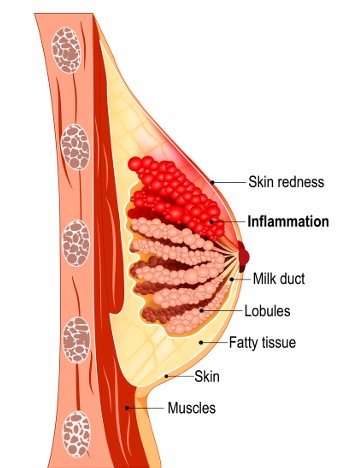Blocked (Plugged or Clogged) Milk Duct Education Series, Part 1: Blocked Ducts Vs Mastitis
Blocked Milk Duct Education Series, Part 1 of 3.
Blocked Milk Ducts Vs Mastitis:

A plugged (or blocked) duct often comes as a surprise to most lactating mums. It is an area within the breast where the flow of milk is obstructed. This can occur at a nipple pore (known as a milk blister) or it can be further back in the ducts. It tends to affect only one breast and often comes on gradually. You won’t likely feel other symptoms, but a low grade fever (less than 38.5 degrees) might be present.
La Leche League states that “blocked milk ducts occur when milk is unable to flow through easily. You may notice redness, or feel a tender spot or a sore lump.”
Kellymom adds that “the location of the plug may shift. A plugged duct will typically feel more painful before a feeding and less tender afterward, and the plugged area will usually feel less lumpy or smaller after nursing. Nursing on the affected side may be painful, particularly at letdown.”
Mastitis (inflammation of the breast) happens when a blocked duct doesn’t clear and causes localized swelling and inflammation. La Leche League adds that “It is also possible for the breast to become infected .If you have mastitis, you may have a higher fever (likely above 38.5) and may feel like you have the flu.
La Leche League notes that you are more likely to develop a breast infection if you stop feeding from a breast that already has a blocked duct or mastitis. They say that “your commitment to breastfeeding [or breast-to-bottle feeding – author’s note added] your baby can be truly tested at times like this, especially when putting your baby to the breast may be the last thing you feel like doing. However continuing to breastfeed frequently is part of the solution and stopping suddenly is likely to make the problem a great deal worse.”
It is crucial to address engorgement and blocked ducts as soon as possible to avoid the progression to mastitis or even an infection, and be sure to address any possible causes.
Always contact your health care provider if you have concerns about the possibility of mastitis.
In Squamish, we are fortunate to have an exceptional group of practitioners to help with lactation questions, including the new collaboration between Mountain Maternity and Roots Midwives, and Anna Turyk of Nuture Sea To Sky Lactation Consulting Services. La Leche League Squamish is also an excellent resource.
Strategies to treat and prevent clogged ducts, including treatments I offer in the clinic, are coming up in the next post!

